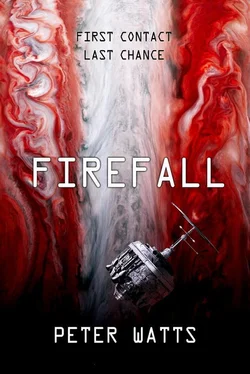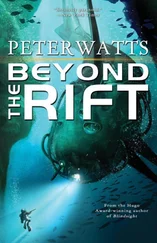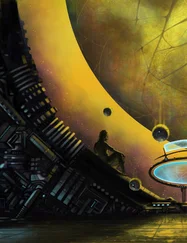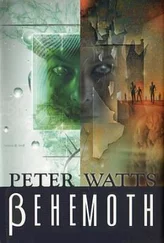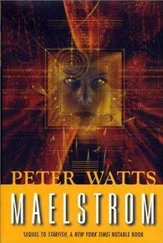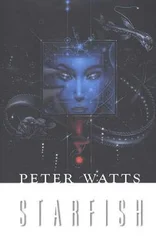And believe it or not, those screaming faces Sarasti used near the end of the book represent a very real form of statistical analysis: Chernoff Faces, [153] Chernoff, H. 1973. Using faces to represent points in k-dimensional space graphically. Journal of the Americal Statistical Association 68:361-368.
which are more effective than the usual graphs and statistical tables at conveying the essential characteristics of a data set. [154] Wilkinson, L. 1982. An experimental evaluation of multivariate graphical point representations. Human Factors in Computer Systems: Proceedings . Gaithersberg, MD, 202-209.
ECHOPRAXIA
ACKNOWLEDGMENTS

It’s been a while. Three editors, three family deaths, one near-fatal brush with flesh-eating disease. A felony conviction. A marriage.
Now this.
I’m not quite sure what “this” is, exactly—but for good or ill, I couldn’t have pulled it off without help. In fact, I wouldn’t even be alive now without help. So first and foremost, let me acknowledge the contribution of one Caitlin Sweet. Echopraxia would not exist without her, because I would not exist without her; I would have died of necrotizing fasciitis on February 12, 2011. (Darwin Day. Seriously. Look it up.) As a perverse reward for saving my life, Caitlin got to endure endless hours in the shower, or in bed, or at restaurants, listening to me whinge endlessly about how this scene was too talky and that climax too contrived; she would then suggest some elegant solution that might have occurred to me eventually, but probably not before deadline. Her insights are golden. If their implementation sucks it’s my fault, not hers.
The first couple of chapters also had the benefit of being workshopped by two different groups of writers: those at Gibraltar Point (Michael Carr, Laurie Channer, John McDaid, Becky Maines, Elisabeth Mitchell, Dave Nickle, Janis O’Connor, and Rob Stauffer); and those at Cecil Street (Madeline Ashby, Jill Lum, Dave Nickle—again—Helen Rykens, Karl Schroeder, Sara Simmons, Michael Skeet, Doug Smith, Hugh Spencer, Dale Sproule, and Dr. Allan Weiss).
I’ve kept lists over the years, tried to document the various insights, references, and crazy-ass hallucinatory what-ifs that informed the writing of this book. I’ve tried to keep track of those who sent me papers and those who actually wrote the damn things, those who made offhand remarks in blog posts or jabbed a finger at my chest while making some drunken point during a barroom debate. I wanted to list everyone by the nature of their contribution: beta reader; scientific authority; infopipe; devil’s advocate.
For the most part, I couldn’t do it. There’s just too much overlap. All those superimposed colors turn the Venn diagram into a muddy gray disk. So, for the most part, I’ll have to fall back on alphabetical order when I thank Nick Alcock, Beverly Bambury, Hannu Bloomila, Andrew Buhr, Nancy Cerelli, Alexey Cheberda, Dr. Krystyna Chodorowksa, Jacob Cohen, Anna Davour, Alyx Dellamonica, Sibylle Eisbach, Jon Enerson, Val Grimm, Norm Haldeman, Thomas Hardman, Dr. Andrew Hessel, Keith Honeyborne, Seth Keiper, Dr. Ed Keller, Chris Knall, Leonid Korogodski, Do-Ming Lum, Danielle MacDonald, Dr. Matt McCormick, Chinedum Ofoegbu, Jesús Olmo, Chris Pepper, Janna Randina, Kelly Robson, Patrick “Bahumat” Rochefort, Dr. Kaj Sotala, Dr. Brad Templeton, and Rob Tucker. And some mysterious dude who only goes by the name “Random J.”
Some folks, however, went above and beyond in singular and specific ways. Dr. Dan Brooks ranted and challenged and acted as occasional traveling companion. Kristin Choffe did her best to teach me the essentials of DNA barcoding, although she couldn’t keep me from sucking at it. (She also fronted me a vial containing the refined DNA of a dozen plant and animal species, with which I washed out my mouth before submitting a cheek swab to the Department of Homeland Security.) Leona Lutterodt described God as a Process, which lit an LED in my brain. Dr. Deborah McLennan snuck me through the paywalls. Sheila Miguez pointed me to a plug-in that made it vastly easier to insert citations into Notes and References (I will understand if, after reading that section, you decide to hate her for the same reason). Ray Neilson kept me on my toes and kept my Linux box running. Mark Showell saw me working on a laptop that was literally held together with binder clips, and took pity. Cat Sparks moved me halfway around the world; she was the fulcrum that tipped the worst year of my life into the best.
Some of these people are meatspace friends; others are pixelpals. They’ve argued with me online and off, punched holes in whatever bits of Echopraxia leaked out during gestation, passed me countless references on everything from hominid genetics to machine consciousness to metal-eating bacteria. They are a small army but a very smart one, and despite my best efforts I’m probably forgetting some of them. I hope those I’ve neglected here will forgive me.
Howard Morhaim. After dealing with agents whose advice ran the gamut from Buy my book to I’ll only represent you if you write a near-future techno-thriller about a marine biologist, Howard told me to write what I was inspired to: selling it, he insisted, was his job. This might not be the most opportunistic attitude to adopt in a Darwinian marketplace, but man it was nice to run into someone who put the writing first for a change.
Ironically, my next novel is most likely going to be a near-future techno-thriller about a marine biologist.
NOTES AND REFERENCES

I am naked as I type this.
I was naked writing the whole damn book.
I aspire to a certain degree of discomfort in my writing, on the principle that if you never risk a face-plant you never go anywhere new. And if there’s one surefire way to get me out of my comfort zone, it’s the challenge of taking invisible omnipotent sky fairies seriously enough to incorporate into a hard SF novel. The phrase “faith-based hard SF” may, in fact, be the ultimate oxymoron—Clarke’s Third notwithstanding—which means that Echopraxia could be my biggest face-plant since βehemoth (especially in the wake of Blindsight, which continues to surprise with all the love it’s garnered over the years). And thanks to a lack of empirical evidence (as of this writing, anyway) for the existence of deities, I can’t even fall back on my usual strategy of shielding my central claims behind papers from Nature .
I can try to shield everything else there, though. Perhaps that will do.
PSY-OPS AND THE CONSCIOUSNESS GLITCH
I’m not dwelling too much on consciousness this time around—I pretty much shot my load on that subject with Blindsight —except to note in passing that the then-radical notion of consciousness-as-nonadaptive-side-effect has started appearing in the literature, [1] D. M. Rosenthal, “Consciousness and Its Function,” Neuropsychologia 46, no. 3 (2008): 829–840.
and that more and more “conscious” activities (including math! [2] Asael Y. Sklar et al., “Reading and Doing Arithmetic Nonconsciously,” Proceedings of the National Academy of Sciences (November 12, 2012): 201211645, doi:10.1073/pnas.1211645109.
) are turning out to be nonconscious after all [3] Ap Dijksterhuis et al., “On Making the Right Choice: The Deliberation-without-Attention Effect,” Science 311, no. 5763 (February 17, 2006): 1005–1007, doi:10.1126/science.1121629.
, [4] Christof Koch and Naotsugu Tsuchiya, “Attention and Consciousness: Two Distinct Brain Processes,” Trends in Cognitive Sciences 11, no. 1 (January 2007): 16–22, doi:10.1016/j.tics.2006.10.012.
, [5] Ken A. Paller and Joel L. Voss, “An Electrophysiological Signature of Unconscious Recognition Memory,” Nature Neuroscience 12, no. 3 (March 2009): 349+.
(though holdouts remain [6] C. Nathan DeWall, Roy F. Baumeister, and E. J. Masicampo, “Evidence That Logical Reasoning Depends on Conscious Processing,” Consciousness and Cognition 17, no. 3 (September 2008): 628–645, doi:10.1016/j.concog.2007.12.004.
).
Читать дальше
